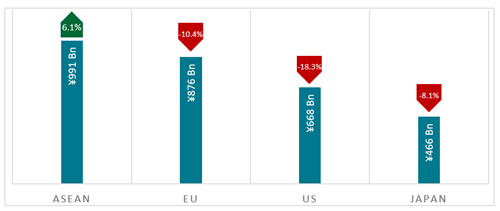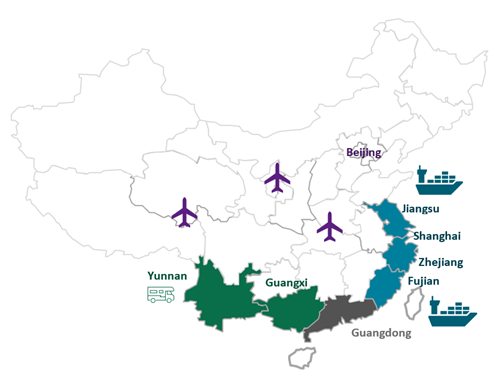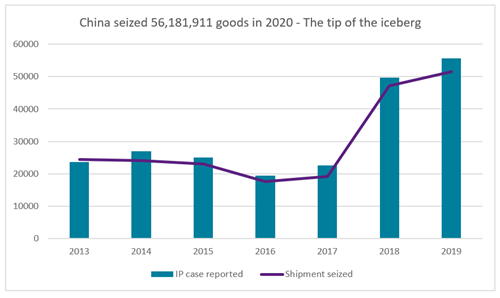7 October 2021|
CHORUS is all about providing data to you and your brand protection teams to help you run successful enforcement campaigns. As well as the data held within CHORUS, it is useful to understand the counterfeiting landscape in the countries where your brands may face problems and how these products move across different countries or regions. With that in mind, we wanted to share the results of some research that Rouse, the IP services business behind CHORUS, conducted on behalf of the UK Intellectual Property Office (IPO UK).
Earlier this year, the IPO UK engaged Rouse to study the cross-border trade in counterfeit goods between China and South East Asia (SE Asia), focusing on branded consumer goods industries in which the UK leads. This updates a similar 2015 report and covers developments in routes, the impact of e-commerce growth, the COVID-19 pandemic, and changing patterns in the SE Asian counterfeit trade. We have summarised the findings of the report for our CHORUS users.
Over the last 5 years, bilateral trade and economic cooperation between China and the ASEAN region has continued to show steady growth. In 2020, the ASEAN region became China’s largest trading partner, overtaking the EU, for the first time.
China’s Foreign Trade with key partners, Q1 2020 (In billion RMB)
Growing internet penetration and e-commerce trade has led to a significant increase in the number of small airfreight shipments (through large postal and courier hubs) to the region.
The complexity of this channel has increased leading to a wider range of counterfeit goods channels of trade, challenging large sea freight containers as the main means of shipping counterfeits to the region.
Counterfeit & Illicit Goods Trade
The import and export trade in counterfeits is part of a wider trade in smuggled illicit goods (alcohol, tobacco and other highly taxed goods) as well as illegal traffic(people, narcotics, synthetic drugs, medicines, firearms, timber wildlife) which is prevalent in South East Asia ( “SE Asia”), as well as a grey economy problem of non-compliance with regulations and non payment of tariffs and duties.
Weak border regimes compound this. There is a a long and porous land borderbetween China and Vietnam, Laos and Myanamr. A lack of oversight andcorruption contributes to this vast trade in illegal goods. Counterfeiting does not exist in a vacuum and needs to be addressed as part of an overall strategy to improve customs effectiveness at preventing all kinds of illicit trade. This will mean partnering with organizations that are also seeking to stop human, wildlife, narcotics, contraband and other trafficking.
CHINA CONTINUES TO BE THE GLOBAL SOURCE OF COUNTERFEIT GOODS EXPORTED WORLD-WIDE AND TO SE ASIA
China’s role in counterfeit trade cannot be overstated. Counterfeit goods from China are estimated to make up approximately 12.5 % of China’s total exports and over 1.5 % of its GDP. Several comparative analyses rank the country as the primary source of global counterfeit goods (around 75% of all counterfeits worldwide). Data now puts the value of the trade of counterfeit goods from China into SE Asia as approximately USD35 billion. The volume poses significant harm to developing economies within SE Asia where local businesses and investors suffer heavy losses from these activities.
Free Trade Zones (FTZs) and Special Economic Zones (SEZs) are vital for global trade. They support numerous industries and provide many different functions. Many countries in SE Asia have FTZs and SEZs. Several reports suggest that FTZs and SEZs are actively supporting illicit and counterfeit trade. FTZs are used to hold, redistribute and facilitate the trade in counterfeit goods, whereas SEZs allow the reprocessing of goods so unbranded packaging can be shipped and then rebranded and packaged for onward transit.
The lack of applicability of domestic laws, and inaccessibility, as well as a lack of oversight from Customs, has led to an environment that enables illicit activities to infiltrate the zones. More needs to be done to raise concerns during counterfeit trade discussions, to increase transparency, and to develop fresh codes of practice on illicit goods. IP owners and governments need to engage with China to create a process or structure in which China can work with its SE Asian trade partners to effectively address the issue.
China-SE Asia Customs & Border Protection
China
China has a sophisticated Customs recordal, data collection and analysis systems in place. The number of IP rights recorded with China Customs has increased year-on-year with over 26,000 IP owners now using the system. The number of seizures conducted by China Customs, continues to grow year-on-year with over 61,000 seizures in 2020. However, only around 1,000 IP owners had successful customs seizures (which represents around 4% of the total number of IP owners – and the quality of the shipping information provided by Customs to IP owners and the criminal authorities on suspect shipments and confirmed counterfeits is limited.
Customs in China needs to continue to improve detection systems as well as improve the quality, quantity and veracity of the shipping information it obtains and shares with IP owners to enable further investigations and legal actions. IP owners need to support Customs by providing greater information, intelligence and training to improve targeting. Additional improvements to the system include minimising storage / warehouse / destruction obligations and costs by speeding up the investigation process, as well as reducing/remove the need for bonds (as indemnities to meet any costs of improper behaviour should suffice).
SE Asia
SE Asian countries have widely varying levels of Customs IP border protection, but apart from Thailand very few counterfeit goods are being seized. The tiny number of recordals and seizures in the region, as compared to regions of similar proportions (such as the EU and China) suggests almost no attempt to impede the flow of counterfeits. The total number of seizures is estimated to be around 1,500, with 1,000 of them occurring in Thailand. Several countries have no effective system: like Malaysia and Indonesia. Other countries such as the Philippines and Vietnam need to improve their current systems.
There is a growing need to invest in extensive IP border protection regimes. A clearer focus on the policy reasons to address the issue is needed within SE Asia’s highest levels of government (such as Ministries of Finance which oversees Customs). Customs training and capacity building should follow after the country has increased seizure capabilities.
Customs IP border systems are generally based on the adoption of international rules (WTO TRIPS) that rely heavily on the IP owner and the court system to identify, police and punish infringers. This has led to ineffective Customs IP border regimes in the region (and elsewhere). The recordal and ex officio seizure systems offered in the UK, China, US and Europe whereby suspect goods are flagged and reported to IP owners, then quickly seized, is the industry gold standard. in SE Asia only Thailand has such a system working effectively.
Impact of Counterfeits
Counterfeit goods from China flowing into SE Asian countries remain largely unchecked. The harms from these counterfeits in SE Asia markets come in a variety of forms. Some pose dangers to consumers (in the form of counterfeit pharmaceuticals and other poor quality, hazardous items), while others negatively impact the local economy (in the form of reduced tax revenue, lost legitimate sales and jobs, and incrementally higher costs). Counterfeiting straddles both the grey and underground economies as well as a harmful criminal economy, worth billions of dollars.
Foreign companies suffer from a loss of sales within the region and yet do not have the resources in SE Asia dedicated to IP protection and enforcement. Many smaller and newer investors suffer from lack of information, resources and ability to handle the problem.
Unfortunately, even though there are multiple surveys and reports every year that discuss these issues it largely remains unchanged. More needs to be done to improve the messaging in relation to the harm caused by counterfeiting to SE Asian governments. Traditional IP lobbying approaches have not worked so more tangible examples of losses and damage will need to be shown.
Customs IP border seizures are a far more cost-effective solution for countries than trying to catch counterfeits through their criminal systems after these goods have entered the country, and shipments have been broken down to be retailed in small volumes.
Rise of E-commerce & Counterfeits
While e-commerce transaction between China & SEA continues to grow, a proportion of it is made up of counterfeit goods. The increase in counterfeits in the market as a result of e-commerce trade was the single biggest concern raised by UK and international companies surveyed for this report.
Global lockdowns and border restrictions as a result of COVID-19 have accelerated the move to online for both illicit and legitimate trade. They have accelerated the transformation of entire supply chains, involving transportation, warehousing, distribution and packaging. E-commerce has become the main platform for a wide variety of counterfeit products, not only for fake and substandard medicines, test kits and other COVID-19-related goods, but also for mainstream consumer products in SE Asia and beyond.
E-commerce trade is dominated by SE Asian platform sales and cross border sales from China.This latter component subdivides into:
-
Chinese sellers selling into SE Asia markets from Chinese platforms and
-
Chinese sellers selling directly on SE Asian platforms.
More and more SE Asian platforms have a cross border sales functionality and are allowing non-resident merchants, especially from China, to sell their goods online. One of the main problems is for SE Asian platforms to identify the many Chinese traders that ship goods through logistics and fulfilment centres in China, which they use as their address/location, and in doing so masking their real identity/location. This makes it easier for Chinese sellers to sell counterfeit goods on SE Asian platforms and is a particular challenge for IP owners in SE Asia trying to tackle remote Chinese merchants. The largest volume of counterfeit sellers however are local SE Asian merchants and drop shippers who source goods directly from China then resell locally.
To address the issue of imported counterfeit goods from China, as opposed to the pure domestic counterfeit issue, more can be done to engage directly with the e-commerce industry (as well as the wider logistics, social media, payment systems and online advertising companies that are also part of the ecosystem) and put in place further proactive online technologies and mechanisms to identify and address the problem. This includes platforms stopping all sellers (including Chinese sellers) appearing on platforms with no clear addresses and identity, as well as forcing sellers to pay deposits that are forfeited in the event of ongoing counterfeiting activity.
Additional legislative changes that clarify the liability of platforms across the region are also needed.
Recent Developments & Trends
There has been no widespread shift of counterfeiting activity from China to other countries in the region. Where some countries, most notably Vietnam, have seen a slight increase in activity, this has been restricted primarily to products that are expensive to transport and can be re-filled in the country (such as lubricants and alcohol) and products that have established competitive local infrastructure and supply chains that can compete with China on price and quality, such as apparel, footwear and textiles). China’s strong counterfeit supply chain network, infrastructure, knowledge base and quality are not things that can be easily replicated in SE Asian countries just yet.
There is no evidence to suggest that China’s Belt and Road initiative has had an impact on counterfeiting activity in the region albeit it could provide a useful forum for building stronger IP and Customs cooperation.
The increased circulation of small parcels is fueling regional cross-border logistics growth and has led to major infrastructure projects and initiatives that are reshaping air cargo, cross-border and maritime connections between China and the region. The increased investment in new technologies, changes to traditional cross-border shipping models and the increased availability of one-stop-shop solutions for Chinese sellers are making it harder for Customs authorities in the region to identify counterfeits and making it easier for counterfeiters to disguise their movements.
We hope this summary has been helpful. If it has highlighted any issues you are currently experiencing in China or South East Asia then our global enforcement head, Nick Redfearn would be delighted to speak to you.









